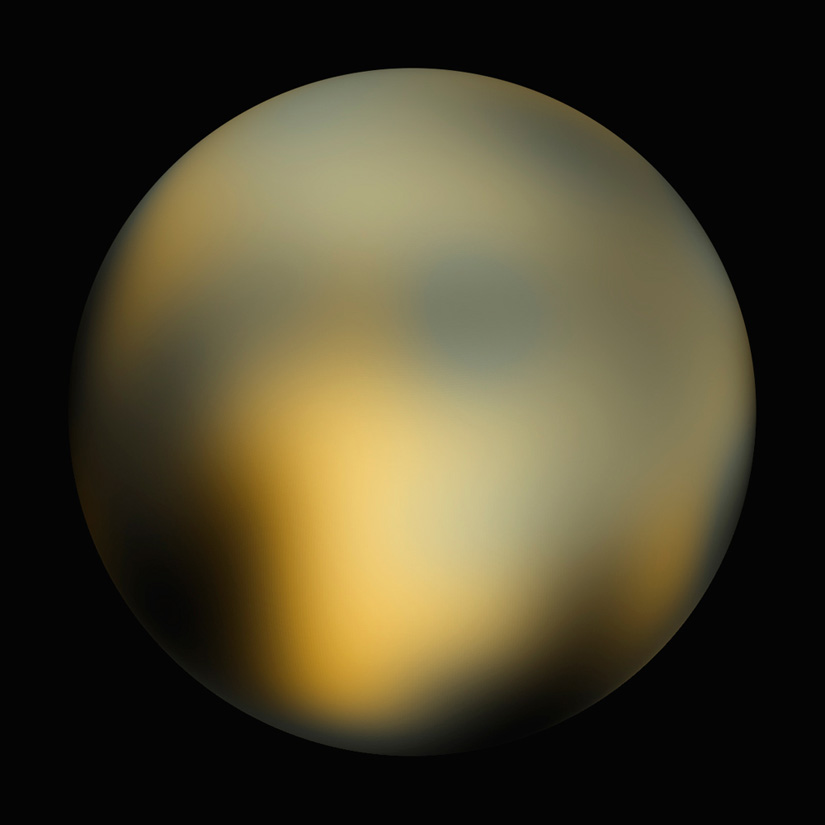

Under good observing conditions, Jupiter’s cloud belts, the Great Red Spot, and shadows of its moons being cast onto its surface are visible, but the larger the telescope, the more detail you’ll be able to see.

The most reliable planets for observing detail on are Jupiter and Saturn. They are also so far away they can be easily mistaken for stars, even in larger telescopes! Neptune and Uranus will show you their respective blue and green color as well as some moons, but will also not show any features in their clouds (even in large telescopes). Venus and Mercury will show you phases like our Moon does, but they will not show any features on their surfaces or clouds. Throw a global dust storm on top and Mars will just look like an orange ball. Even under ideal circumstances, Mars’s features are subtle and require patience to see. One such dust storm occurred this opposition. Further, Mars sometimes undergoes massive global dust storms which can completely obscure its surface features.

Close oppositions like we just experienced happen once every 11–13 years or so. However, Mars only gets close enough to Earth to see meaningful detail for a brief period once every couple of years, and even then, not all Mars oppositions are equal. The only planets that have easily observable features or otherwise notable attributes are Jupiter, Saturn, and Mars. Let’s go through each of the above factors in more detail. Even the most light polluted cities are no match for the bright concentrated light of the major planets. Getting out in the dark countryside to observe planets isn’t necessary, since the major planets are bright enough to be seen even in broad daylight (if you know where to look!). The only thing that won’t degrade the view of the planets, is light pollution.
Not waiting for the telescope to acclimate to the surrounding air temperature. Observing from indoors through a window. Observing over heat sources like rooftops and air conditioning vents. Observing the planet when it’s too low in the sky (too close to the horizon). Poor atmospheric seeing (bad turbulence). Looking at a planet without a lot of detail on it, such as Venus. Moreover, the unfortunate reality is that there are often a number of factors working against the observer’s ability to see detail on the planets: All image processing adds a certain degree of contrast and saturation, and the nature of viewing the images on a typical monitor in a bright room is quite different from how we perceive the light coming from the telescope when our eyes are dark adapted. It should be noted that the surface features on all planets are often far more subtle than they appear to be in images. So, a telescope with a focal length of 1,000mm and a max magnification of 250x will benefit the best from a 4mm eyepiece.Jupiter in a small scope (4–5") under good observing conditions using appropriate magnification. Depending on observing conditions, eyepiece magnification can perform at less than 35x every inch or up to 75x.Īdditionally, if you’d like to utilize every decimal of possible magnification for your telescope, you can divide the focal length of the telescope by the total magnification. So, if you’re picking up a 127 mm (5 inch) telescope, multiply 5 inches by 50, and you have a maximum magnification of 250x.Īnything beyond this point will most likely appear distorted, fuzzy, and dim. The maximum effectiveness for an eyepiece’s magnification is about 50x for every inch of your telescope’s aperture. There is always a limit to the effectiveness of magnification, depending on the telescope’s aperture. The shorter the eyepiece focal length, the greater the magnification, and vice versa. For instance, if a telescope has a 1000mm focal length, and the eyepiece focal length is 10mm, the total magnification of the eyepiece will be 100x. Eyepieces are a collection of lenses that magnify the light gathered by the lens or mirror at the front, presenting a clear image of whatever object you may be observing.Įyepieces have their own focal length as well, which, when divided by the focal length of a telescope, determines the magnification capabilities. But, for us to view the image clearly, telescopes require an eyepiece. The objective or front-end of a telescope gathers the light and focuses it through the tube.







 0 kommentar(er)
0 kommentar(er)
